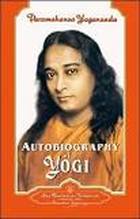
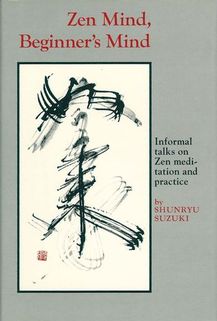
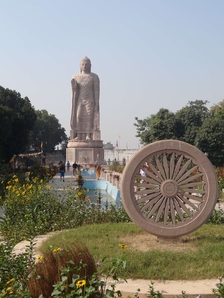
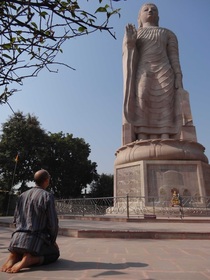
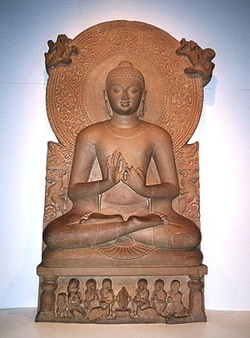
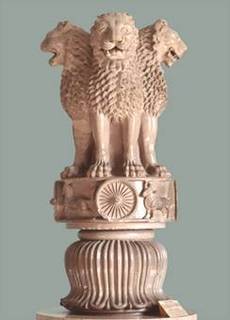
 As my 32nd birthday approaches, I have reflected that Buddhism has now played a role in a full half of my life. It started at age 16, when a stressful residential summer school course led me to look for ways to vent the calculus infused steam from my head. At that time, in a little bookstore in Northfield Mount Hermon Massachusetts, I found a little book called “Yoga for Busy People” that would launch my interest in the spiritual life. Yoga asana helped me to find a bit of peace and eventually led to my interest in meditation when I was introduced to the book “Autobiography of a Yogi” by Parmahansa Yogananda at a little metaphysical bookstore that opened on my street while I had been away at school for the summer (strange coincidence that was – perhaps the universe really does offer what you need when you need it).  Later that summer I worked in my Dad’s epoxy factory and started talking about my experiences with yoga. Hearing my interest in meditation, the lead chemist at my Dad’s company (and later close family friend) gave me a book that would forever change my life. It was titled, “Zen Mind, Beginner’s Mind” and was written by a Japanese Monk, Shunryu Suzuki, who had come to America and found many Western students interested in learning the practice of Zen Buddhism. I read the book and found Zen meditation truly engaging, but for the next 3 years my focus was on Kundalini meditation as I received mailings from Yogananda’s group SRF (Self-Realization Fellowship) that taught different forms of pranayama (moving energy through the body with breath) for the purposes of opening the mind’s eye to the broader components of the universe. The various meditation practices instantly resonated with me. My previous interest in business management withered as I felt my heart opening to the suffering of people around me. Suddenly I found myself searching for philosophy books in the library and founding a meditation club in my high school for others with interest.  Thai Temple - Sarnath Yogic meditation is very colorful and the path is full of somewhat magical beliefs about the powers attained by yogis in the advanced stages of meditation. As a young person, it was all very exhilarating and at the age of 19, during my first summer after college, I headed out to the SRF monastery for 2 weeks to see if I might want to pursue the life of a monk. But there was a problem that my now philosophically minded viewpoint couldn’t overcome. Yogananda had died years before and to take him as my guru as SRF requested in order to move forward with the training, was a step I was unwilling to take. I hadn’t had any experiences that supported that Yogananda could guide me from the astral plane as the monks suggested. In fact, the whole thing just started to seem too strange and I left the monastery feeling discouraged because I wasn’t able to take the leap of faith required to continue with SRF.  But Zen Buddhism was my life preserver in those choppy seas of self doubt. At that point, I had read Suzuki’s book hundreds of times and regularly practiced Zen along with my yogic practices. I realized that Zen offered me the compassionate and mindfulness based path that SRF had, but without the need for ascribing to beliefs of which I had had no direct experience. In fact, the Buddha always demanded that his students take nothing on faith, but always test his own words in the world of their experiences. This empirical and pragmatic approach was just what a disillusioned yogi needed. Zen became my primary spiritual practice and has stayed so until this day. Zen has been good to me. It brought me wonderful teachers and friends at the San Francisco, Missouri and Austin Zen Centers, and at the Great Sky Temple in Minnesota. It has led to a shared spiritual life with my wife, who immediately reverberated with a lifestyle of mindfulness and compassion when she meditated with me for the first time in St. Louis. It led to our adventure living in the Zen Center in Austin (AZC), Texas for a year, where we found a wonderful (living) teacher in the form of Seirin Barbara Kohn. At AZC, we learned the forms and traditions of Soto Zen and I took the jukai ceremony, sowing a ceremonial mini-robe (rokasu), taking the Buddhist precepts, and being given a Buddhist name by my teacher. Since leaving Austin on our world travel trip, we have left our community (sangha) behind and at times have struggled to maintain our practice with the diligence we had before.  The Buddha giving his first teaching Within this context, we have been very excited about this part of our trip in India. In Varanasi, we explored a city of death, but just 10km outside of it lies an important place of Buddhist Pilgrimage – Sarnath. It is here that the Buddha first came after reaching enlightenment in Bodhgaya. He sought out 5 ascetics who he had practiced with previously to give his first talk, known in Pali as the Dhammacakkhapavathana Sutta. In a peaceful deer park amidst the chirping of birds and the grazing animals nearby, the Buddha told the ascetics of the 4 noble truths. Firstly, that suffering is a part of life. Secondly, that the cause of suffering is our false idea that we have a separate self that exists in isolation from the rest of the world. This fundamental delusion causes craving and attachment which leads to much suffering for ourselves and others. Thirdly, there is a way to see the nature of reality and our interconnection with it, thus ending suffering. Fourthly, this way incorporates ethics, mental training, and philosophy and is called the eight-fold path. The whole eight fold path is outside the bounds of this blog, but for more information it click the link above. When the Buddha finished his speech, it is said that the 5 ascetics, who had already undergone thorough spiritual training of their own, instantly saw the truth and were enlightened. Thus, this place is considered the birthplace of sangha, or the monastic spiritual community. Though in a more liberal sense, sangha has come to mean the community of all like-minded spiritual seekers who wish to support each other in the practice of seeing the true nature of reality and the compassion such a seeing engenders. Along with our new friend Eric from the previous post about Varanasi, we took an autorickshaw out to Sarnath and visited the Dhamekh Stupa, which is said to mark the location of the famous speech. We sat and meditated in the shade cast by the stupa as strings of devotees circumambulated around it while chanting in Thai, Burmese, Tibetan and other languages. Some women next to us brought their prayer boards, where they would sweep down in prostrations, extending their bodies out on the ground, before gracefully rising, lifting their hands in the air and repeating for hours at a time. The setting was peaceful and Neda and I felt the energy of the place was tangible as our minds were transported to 2,500 years ago when the Buddha brought forth a message that would influence our lives so deeply.  Ashoka Lions The area surrounding the stupa was once a great place of gathering for monks to come and study during the rainy season. Most of the ancient buildings of the libraries and monasteries here have been destroyed, their materials re-purposed for other buildings in Varanasi. But in the modern era, temples from the various nations practicing Buddhism have sprung up around Deer Park. We enjoyed the luxuriant decoration of the Thai Temple and chanted the service at the Japanese Nichiren temple to end the day. We also visited the archeological museum, which featured the Ashoka pillar topped with 4 snarling lions (facing in 4 directions to symbolize the teachings emanating out from Sarnath in all directions) that was placed at the site and has become the symbol of modern India. There is also a spectacular carving of the Buddha assuming the Dharmachakra Mudra, said to represent that first speech. For us, it was a wonderful experience to visit the site, made even more intimate by the presence of our friend Eric who practices in the Tibetan lineage. It really felt like we were making this pilgrimage together as a sangha of different traditions. But in the end, Sarnath would just be a taste of the community and spiritual focus that we would find in Bodhgaya, the place where the Buddha is said to have awakened to the truth. Read about that amazing experience in part 2 of this post! See the pics of Sarnath and some of Bodhgaya here: http://flic.kr/s/aHsjD7kk1j
0 Comments
Leave a Reply. |